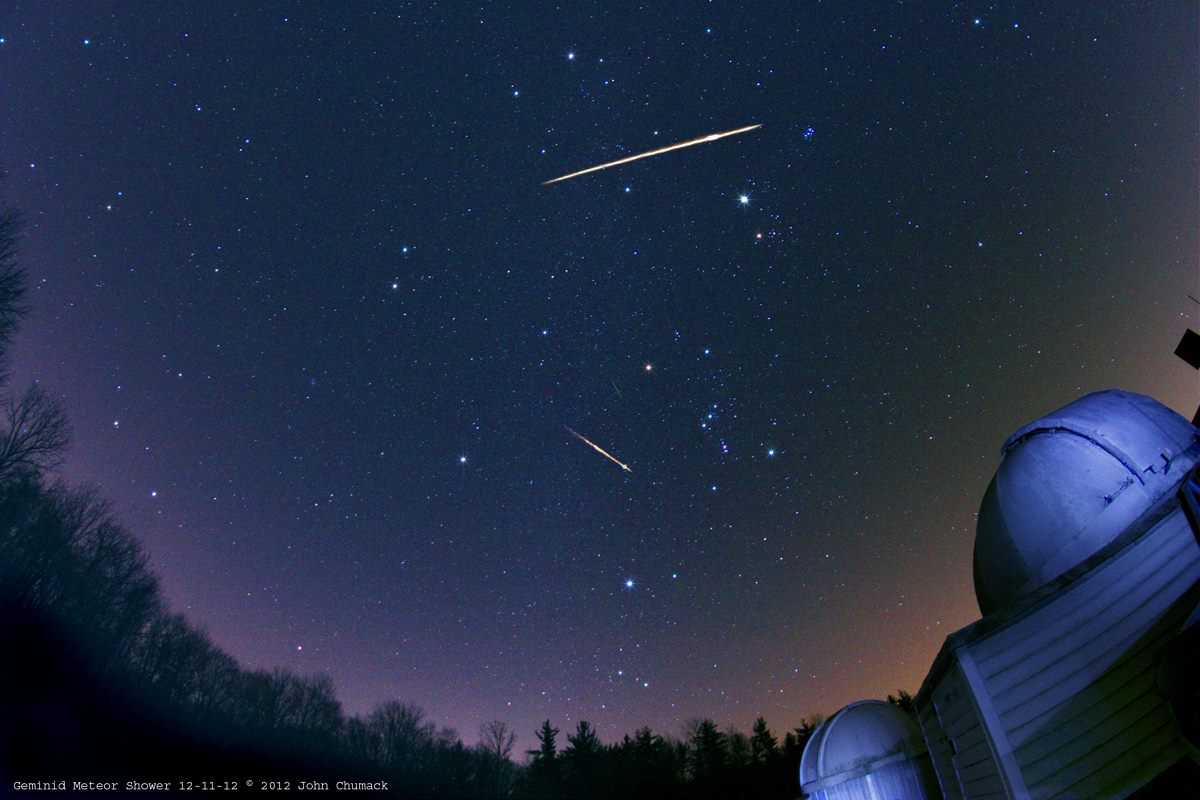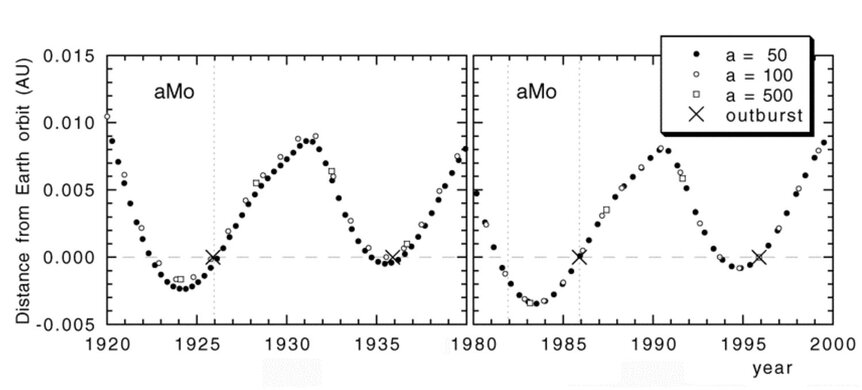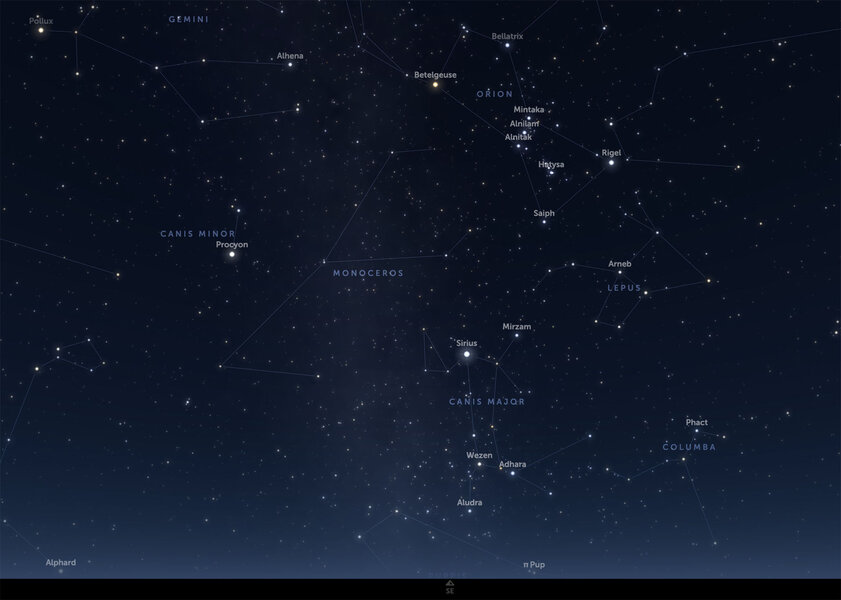Create a free profile to get unlimited access to exclusive videos, sweepstakes, and more!
Will the Unicorn give us a meteor storm on November 22?

Several times during the course of a year, the Earth passes through the debris trail left by a comet orbiting the Sun. This ejecta is in the form of tiny bits of dust, usually not much bigger than a grain of sand. Due to its relative speed, though, this stuff plunges into our atmosphere at dozens of kilometers of second, gets very hot, and glows as it zips across the sky in a second or so.
Thus, meteor showers.
A really good shower, like the Perseids or Geminids, might produce up to 50 or 60 "shooting stars" per hour. Sometimes, though we pass through a particularly dense cloud of material, and the number of meteors can increase hugely. These are meteor storms, and can produce over 1,000 meteors per hour.
On the evening of 21/22 November, we may get such a storm.
The normally quiet Alpha Monocerotid meteor shower usually produces a few meteors per hour. However, in 1925, 1935, 1985, and 1995 there were sudden outbursts of meteors from the shower. 1985 produced about 700 meteors per hour (more than 10 per minute!) and 1995 about 400.
Astronomers have predicted that we may get a storm this year. It's not certain — this kind of prediction is very difficult — but there's a good chance we could get from 100 to 1,000 meteors per hour! However, the storm will be very short-lived, lasting just 15 to 45 minutes. The peak is predicted at 04:50 UTC on 22 November (11:50PM on the night of the 21st for the US east coast). That’s perfect for US viewers!
I'll explain all this (of course!) but to see this event, all you need to do is go outside to a relatively dark site and look up. You don't need any telescopic equipment; in fact you want to be able to see as much of the sky as possible to see meteors wherever they might appear. Bundle up (it's November!) and if you can, lie on the ground or on a lawn chair that allows you to lie down and look up. I have general meteor shower watching instructions from last year’s Geminids which has lots of good info for how to see a shower.
While the shower is spread out over several days, the outburst itself is predicted to peak extremely rapidly at 04:50 UTC. But it could be earlier, so be out by 04:00 or so, which will allow your eyes to adapt better to the dark. Be looking by 04:15, and hang out for an hour, in case the outburst is a bit late. That’s it! If you want to take pictures, the American Meteor Society has a nice set of instructions.
So what’s the cause of this? Comets are, in general, made up of dust and rocks held together by ice. As a comet nears the Sun, the ice sublimates (turns directly into a gas) and that means some of the rocky material is ejected into space. It tends to follow the comet in its orbit, but over time forces act on it — the gravity from planets, the solar wind, pressure from sunlight — to push it onto slightly different orbits.
If the comet's orbit intersects the Earth's orbit, then we move through that debris trail every year at around the same time. This produces a reliable shower, like the Perseids in August and the Leonids in late November. Sometimes, though, the comet might release more debris than usual; maybe on one particular pass of the comet near the Sun a large pocket of ice got exposed and sublimated, releasing more junk than usual. This spreads out in space a bit over time, but still has enough bits of cometary rock to make for an unusually strong meteor shower.
The comet that is the source of the Alpha Monocerotids isn't known; it’s on an orbit that's much longer than 150 years, so it doesn't pass by the Earth very often. But previous meteor showers have allowed astronomers to calculate when storms might occur from it (basically, when the path of the storm gets very near Earth, which changes due to complicated factors), which is why this year is predicted to be a good show. The meteors enter our atmosphere at a speed of over 60 kilometers per second, which is pretty fast, and burn up at an altitude of 90–100 kilometers. So don't worry about getting hit by anything! And remember, the actual meteoroids, the solid bits of matter burning up, are generally a millimeter in size.
The reason this shower has the unwieldy name of the Alpha Monocerotids is due to an illusion. Most meteoroid streams in space are hundreds of thousands of kilometers wide or more, far larger than the Earth. As the Earth plows through them, it’s similar to driving a car through a tunnel with lights on the ceiling. The lights streak by you, and if you trace their path backwards, due to perspective (the vanishing point) they all seem to come from the same direction: ahead of you. In the same way, meteors in a shower all seem to radiate away from a single point in the sky, called the radiant, and its position depends on the Earth's motion and the motion of the debris through space.
In this case, it's near the star Alpha Monocerotis in the constellation Monoceros (the Unicorn). This constellation is made up of faint stars, but it occupies the easily findable real estate on the sky between the constellations of Orion, Canis Minor, and Canis Major. After sunset in November, look east to see Orion rising. Monoceros is to the left of it (for northern hemisphere observers). Procyon is the brightest star in Canis Minor, and Sirius (the brightest star in the night sky) the brightest in Canis Minor (the stars in Orion's Belt point right to it). Monoceros is in the triangle formed by those two stars and Betelgeuse, the red star marking Orion’s shoulder.
The meteors will appear to move away from that part of the sky, but can appear anywhere in the sky. So again, a wide view of the sky is what you want, and a dark site to see fainter meteors. Happily, the Moon won't be interfering with this event, either.
Given that this happens not long after sunset, if skies here in Colorado are clear I'll definitely be out to see if anything happens! Remember, it might not — it's a prediction after all, not a certainty — but if the Unicorn storms that night, it'll be something to see. I've never seen an outburst myself, so I'm very hopeful we’ll see lots of cometary debris plunging through our sky.
Tip o' the Whipple Shield to astronomer David Grinspoon on Twitter for linking to an article about this.




























